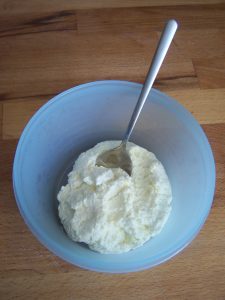 To make my own Ricotta is one of the things I have for a long time on my toDo list. I read a lot about it in diffrent blogs and it sounds not to complicated. The only complicated thing was to choose a recipe, because there are so many diffrent varients: Claudia of Fool for Food used buttermilk, like Lauren of I’ll eat You, Nick & Sara of IMAfoodblog used whey from their mozzarella production and the Hedonistin (Low Budget Cooking) grapefruit juice.
To make my own Ricotta is one of the things I have for a long time on my toDo list. I read a lot about it in diffrent blogs and it sounds not to complicated. The only complicated thing was to choose a recipe, because there are so many diffrent varients: Claudia of Fool for Food used buttermilk, like Lauren of I’ll eat You, Nick & Sara of IMAfoodblog used whey from their mozzarella production and the Hedonistin (Low Budget Cooking) grapefruit juice.
I also found variants using vinegar, citron juice or magnesium sulfate. For my first trial I choosed citron juice, but the Ricotta this recipe yielded hat a sour taste and it structure was similar to cottage cheese.
So I resarched a little bit more and found the comment von Ostwestwind (Küchenlatein) on Low Budget Cooking, that when using an acid like citron juice or vinegar you precipitate casein instead of globuline and albumine of the whey like in real ricotta.
So I need whey! Having not enough time to get whey by making my own mozzarella like IMAfoodblog (though mozzarella making is now on my toDo-List) I buied a beaker of whey in the supermarket. And this time I was satisfied with my ricotta. Creamy with a very small hint of sour, very tasty!
Ricotta
yields 130g
- 500g whey
- 500g whole milk
Warm milk and whey to 70°C. Wait 30 min untill the precipitated Proteins comes up to the sureface. Ladle the curds in a sieve linned with a cheese cloth and let drain for 1 to 2 hours.
It should keep fresh up to 5 days in fridge, but my ricotta was used up directly, so I did not test this.
- 500g Vollmilch (Biovollmilch von Rewe mit 3,8% Fett)
Molke und Milch in einem Topf auf etwa 70°C erhitzen. 30 min stehen lassen, bis sich die ausgefallenen Proteine an der Oberfläche abgesetzt haben. Diese in ein mit einem Tuch ausgeschlagenes Sieb schöpfen und 1-2 Stunden abtropfen lassen.
Soll im Kühlschrank bis zu 5 Tagen halten – soweit ist es bei uns aber nicht gekommen, da der Ricotta direkt weiter verarbeitet wurde.
Deutsch



ich dachte das hieße ri-cotta, weil man die Molka nochmal verwendet.
@ Alexander: Für Ricotta werden tatsächlich Proteine aus der Molke gefällt, dazu muss man der Molke allerdings Milch zusetzen, da für diesen Vorgang Casein benötigt wird, welches in der Molke nicht (mehr) vorhanden ist. Würde man Molke alleine aufkochen, würden die Molkeproteine (vor allem Albumin) zwar denaturieren, wären aber so fein, dass man sie nicht ohne weiteres aus der Masse entfernen könnte. Durch das Casein bilden sich größere “Klumpen”, die man dann herausfiltern kann.
Deshalb verwende ich in dem Rezept auch eine Mischung aus Ricotta und Molke.
Das ist eigentlich kein richtiger Ricotta, denn der wird 2x gekocht,deshalb der Name Ri-cotta. Das heisst, du müsstest die aufgefangene Molke nochmals kochen. Das habe ich mal gemacht und hatte am Schluss 1 EL Ricotta. 😉
Der Versuch mit der Molke steht bei mir noch aus. In meinem Bio-Supermarkt gab es keine reine Molke, der andere Markt, der sie auf jeden Fall hat, ist zu weit weg. Dein Ricotta sieht sehr appetitlich aus.
@ Nick, of course I can tutor you in German, but could you bring then some white whole wheat flour with you, please? I can not find it here neither in supermarkets nor wholefood shops nor in the internet.
Maybe we should mix german and american supermarkets, so you get the pizzaoven and whey and I get a greater choice of flour 🙂
PSS Now that I think about it, with whey available at the market and that awesome pizza oven thing you have that isn’t for sale in the USA, maybe I should just move over there and be done with it? Do you think you could tutor me in German? 🙂
The acid set cheeses NEVER hold up compared to real ricotta (though they are good vs. store bought usually in a pinch).
I’m so happy that you finally got some that meet our expectations, nothing like the real deal!
PS I’m surprised you got whey at your supermarket. I have never seen it for sale anywhere except at a farmer’s house.